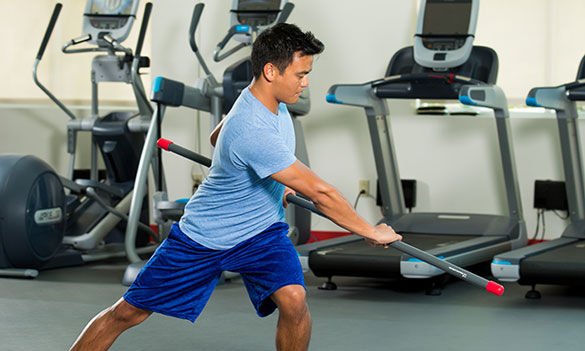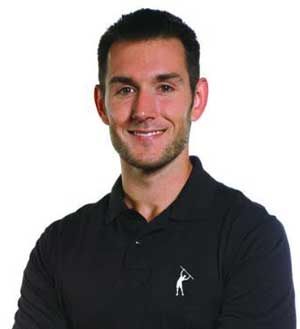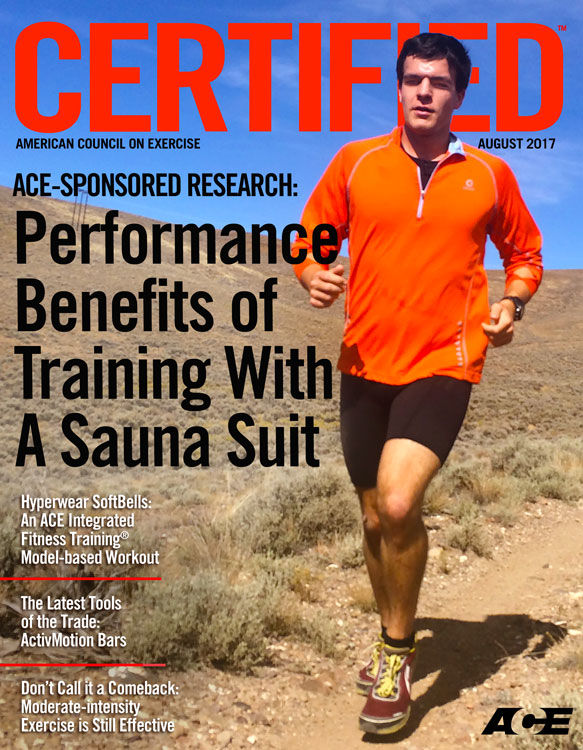
The standard Olympic barbell weighs approximately 45 pounds, which can be too heavy for many fitness consumers. As a result, lighter-weight steel bars covered in foam rubber were created to meet this need. For years, these weighted bars have been standard equipment on gym floors and in group-fitness studios, with little change or variation in design except to add longer or heavier options. That is, until the introduction of ActivMotion Bars. In this latest installment of our Tools of the Trade series, we examine whether, as the manufacturer claims, one simple design change to standard weighted bars can create an entirely different exercise experience.
The Product
One of the challenges faced by many sedentary and older adults is the ability to control the body’s center of gravity over a constantly changing base of support, commonly called dynamic balance. Being able to reflexively react in a coordinated and efficient manner to maintain control of the body’s movements in a constantly changing environment is another common issue. Derek Mikulski, a personal trainer based in Detroit, Mich., created the ActivMotion Bar (AMB) to specifically address these issues with his own clients.
 The change Mikulski made was to add ball bearings to the inside of a hollow steel bar, thus creating a resistance-training tool with a dynamic, moving mass that allows users to improve the skills of proprioception and balance while also increasing muscular strength. AMBs come in two different sizes, a 4-foot version that weighs 4.5 pounds and a 6-foot version that comes in five different weights: 6, 8, 10, 15 and 18 pounds.
The change Mikulski made was to add ball bearings to the inside of a hollow steel bar, thus creating a resistance-training tool with a dynamic, moving mass that allows users to improve the skills of proprioception and balance while also increasing muscular strength. AMBs come in two different sizes, a 4-foot version that weighs 4.5 pounds and a 6-foot version that comes in five different weights: 6, 8, 10, 15 and 18 pounds.
“The ‘why’ behind the ActivMotion Bar is twofold,” explains Mikulski. “For one, I worked with lots of older adults who didn’t like standing on balance platforms during stability or balance-oriented exercises. As I was looking for strategies to help them improve their balance using methods that helped them feel safe, I decided that putting the instability in their hands was a functional solution that would allow them to feel safe while making improvements in body awareness and dynamic balance.”
Mikulski’s second reason for creating the AMB stemmed from personal observations in the gym. “I noticed that even though they are exercising regularly, many people in the gym are only doing exercises that focus on one-dimensional, linear movements,” he explains. “In life, we don’t move in just one direction or plane of motion. We bend, twist, shift, stretch, reach or balance—sometimes doing all of these actions at the same time. With the AMB, I wanted to develop a product that challenged my clients like they are challenged in life and sport, with high degrees of variable and unpredictable movements.”
According to the company, the shifting mass of the ball bearings inside of the bar creates a variable and changing load that can help strengthen the contractile element of muscle fibers as well as the elastic component of the fascia and connective tissue responsible for binding all fibers together. In addition, being able to control the movement of the AMB helps users learn how to reflexively respond to changes in load and challenges to the body’s inherent equilibrium. The movement of the ball bearings inside of the bar creates an auditory feedback response, which allows users to not only feel but also hear their movements. This can enhance proprioceptive response, enabling a user to develop greater balance and awareness of his or her body’s position in space.
In 2014, the company contracted with the University of Michigan’s Human Movement and Innovation Lab to conduct a study to quantify how using the AMB compares to using a standard, weighted bar. The researchers observed that as the weight shifts within the bar, users experience up to 173% more muscle activation. According to Mikulski, even the company was surprised by the findings. “I could see the benefits in my clients, but the findings of the study blew me away,” he says.
First Impressions
The ActivMotion Bar is one of very few products that has caused us to hit our heads and wonder, “Why didn’t we think of this?” The seemingly small change of adding moving ball bearings to a weighted bar creates a completely unique exercise experience not easily produced by other products. When first using the AMB, we played around with a variety of multiplanar movement patterns, which allowed us to really feel how the ball bearings moved inside of the bar. We really liked the shifting mass and could feel how it affected the connective tissue as the bar moved through rapid changes in position. Conversely, trying to move slowly to keep the ball bearings from moving created a significant challenge as well. We found that no matter how slowly we moved, it was really difficult to keep the ball bearings stable. This type of slow-motion training can be helpful for engaging all of the fibers within a specific section of muscle.
One of the features we really liked about the AMB is the metal surface. A drawback to many traditional weighted bars is that the foam rubber coating flakes off, creating unsightly trash in the studio and leaving the solid metal of the bar exposed. Unlike bars with foam rubber coatings, the construction of the AMB creates a durable product that should allow for years of use without the need for replacement.
The only minor issue we had with the AMB was the volume of the noise created by the metal ball bearings moving inside of the metal tube. As mentioned earlier, this auditory feedback can be an important component of the learning process for users exercising with the AMB. However, if a number of people are using them at the same time (in a group fitness class, for example) it can become noisy. While this is not a major issue, addressing it could create an even better user experience.
The Response
Leslee Bender is a group fitness instructor, ACE Certified Personal Trainer and international educator who enjoys using the AMB for both clients and group workouts.
“[The AMB] gives the client an automatic response when holding it that stimulates the intrinsic muscles to activate,” says Bender. “And more importantly, it gives a trainer the opportunity to train for balance without ever having to compromise safety and putting a risk before a benefit.” Bender appreciates the fact that she doesn’t have to put her clients on an unstable surface when she’s using the AMB.
Like Bender, Abbie Appel, an ACE Certified Group Fitness Instructor in Boca Raton, Fla., and an ActivMotion Bar Master Trainer, also uses the bars for teaching group classes and workshops.
“When working out with the [AMB], the momentum of the rolling weights challenges a number of muscles to work reflexively in reaction to the shifting mass, which automatically engages many of the deep core muscles used for spinal stability,” explains Appel. “In addition, I find that my job as an instructor is easier because the movement of the weights rolling in the bar creates automatic feedback, which lets participants know whether they’re using correct or incorrect form.”
Workout Options
The AMB can be used like a traditional weighted bar, but the shifting mass allows for unique variations for both rotation and dynamic strength-training exercises. The following workout is designed to take advantage of the shifting mass inside of the AMB to help strengthen both the contractile and elastic components of the myofascial system.
The ball bearings inside the bar comprise approximately 30% of the weight of each AMB. When first introducing a client to using an AMB, select a weight that is 20 to 30% lighter than the weight he or she might normally use with a traditional, static weight. For example, if a client usually uses a bar that weighs 12 or 15 pounds, start with either the 8- or 10-pound AMB. As the client develops the strength needed to react to and control the dynamic mass, he or she can transition to using a heavier AMB.
A few safety notes regarding the exercises included in this workout:
- When performing the rotational movements, it is important to keep the spine long and extended to emphasize rotation from the hips and feet.
- During the strength-training exercises, specifically the crunch-to-pullover and the reverse lunge to single-leg Romanian deadlift, be sure to remind clients to move slowly in an effort to minimize the amount the ball bearings travel inside of the bar. This helps to keep the contractile element of muscle under tension longer, which results in a greater strength-training benefit.
- When performing the dynamic movements, specifically the lateral lunges and lateral bounds with reaches, the shifting mass of the ball bearings will help to strengthen the fascia and connective tissue. This is important for reducing the risk of injury, so start with steady and controlled movements before progressing to more explosive actions.

Final Thoughts
Small changes can lead to big results. Performing multidirectional movements while carrying loads such as groceries, laundry or even young children is the kind of thing many clients do in their daily lives, but are often overlooked in traditional exercise programs. It’s important to realize that many strength exercises only focus on specific muscle groups or movement patterns, and don’t engage all of the fascia and elastic tissue responsible for connecting all muscles to one another. Performing resistance-training exercises in a variety of movement patterns using a shifting mass enables clients to train and prepare for the constantly changing challenges of daily life.
If you are looking for creative and effective ways to help clients of all skill levels achieve results from their workout programs, the ActivMotion Bar is worth considering adding to your equipment list.
Derek Mikulski: From Personal Trainer to Entrepreneur
 After changing his behaviors and habits, Derek Mikulski lost 100 pounds and decided to make a career of helping others do the same. After earning a bachelor’s degree in exercise science and health education and becoming a Certified Strength and Conditioning Specialist (CSCS), he started his career as a personal trainer. It was during his work with older clients that Derek realized there was a need for a different type of balance equipment other than the standard platforms and balance discs.
After changing his behaviors and habits, Derek Mikulski lost 100 pounds and decided to make a career of helping others do the same. After earning a bachelor’s degree in exercise science and health education and becoming a Certified Strength and Conditioning Specialist (CSCS), he started his career as a personal trainer. It was during his work with older clients that Derek realized there was a need for a different type of balance equipment other than the standard platforms and balance discs.
Like many entrepreneurs, Mikulski began tinkering in his garage with various types of equipment before settling on the current version of the ActivMotion Bar. Since launching the ActivMotion Bars in 2014, he worked around the clock to promote his product and introduced it to a number of countries around the world. The fitness industry is a crowded marketplace, which makes launching a new product particularly challenging. However, as Mikulski learned, there is always room for a new product if it meets a particular need and is supported by evidence-based science. If you have an idea for a product and are wondering how to get started, Mikulski offers the following words of hard-earned advice:
How has the transition been from fitness professional to entrepreneur?
This has been an incredibly lengthy and difficult learning experience that I could spend days discussing, but I have enjoyed it immensely. The transition from trainer to business owner has been an intense grind filled with ups and downs, but I believe in my product and know it can make a difference in people’s lives. And that’s what keeps me motivated. Starting from scratch, you quickly understand why fewer than 5% of all businesses make it past the two-year mark.
What has been the biggest surprise?
The biggest surprise has been the amount of time it has taken to reach a critical mass of people powerful enough to carry the brand and increase the level of awareness of the ActivMotion Bars. There are so many products and a tremendous amount of competition in the fitness world, which gives the general consumer thousands of options to choose from. Once we do get in front of a potential customer, whether a health club chain or individual trainer, and they use the bars, we see their eyes “light up” because they can feel the benefits immediately.
What has been biggest challenge?
The greatest challenge has been rising above the noise of the crowded marketplace while maintaining a disciplined focus on our core customers. There are lots of opportunities out there, so knowing where to invest time and money to have the greatest impact is critical and has provided the greatest learning experiences.
Any words of advice?
Be passionate about what you are doing and have a strong “why,” which will carry you through the many struggles you will face bringing your product to market and getting it in front of potential customers.





 by
by 

 The change Mikulski made was to add ball bearings to the inside of a hollow steel bar, thus creating a resistance-training tool with a dynamic, moving mass that allows users to improve the skills of proprioception and balance while also increasing muscular strength. AMBs come in two different sizes, a 4-foot version that weighs 4.5 pounds and a 6-foot version that comes in five different weights: 6, 8, 10, 15 and 18 pounds.
The change Mikulski made was to add ball bearings to the inside of a hollow steel bar, thus creating a resistance-training tool with a dynamic, moving mass that allows users to improve the skills of proprioception and balance while also increasing muscular strength. AMBs come in two different sizes, a 4-foot version that weighs 4.5 pounds and a 6-foot version that comes in five different weights: 6, 8, 10, 15 and 18 pounds. 
 After changing his behaviors and habits, Derek Mikulski lost 100 pounds and decided to make a career of helping others do the same. After earning a bachelor’s degree in exercise science and health education and becoming a Certified Strength and Conditioning Specialist (CSCS), he started his career as a personal trainer. It was during his work with older clients that Derek realized there was a need for a different type of balance equipment other than the standard platforms and balance discs.
After changing his behaviors and habits, Derek Mikulski lost 100 pounds and decided to make a career of helping others do the same. After earning a bachelor’s degree in exercise science and health education and becoming a Certified Strength and Conditioning Specialist (CSCS), he started his career as a personal trainer. It was during his work with older clients that Derek realized there was a need for a different type of balance equipment other than the standard platforms and balance discs. 
